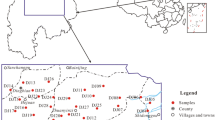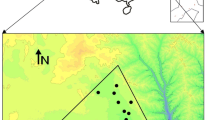Abstract
Groundwater quality significantly affects public health. In order to better understand groundwater suitability, a total of 887 shallow groundwater samples were collected from the Hetao Plain (HP), Inner Mongolia, China; the maximum and minimum health guideline values of each element were established in this work. Subsequently, the desirability functions (DFs) theory was employed to evaluate the human health risk of groundwater. The results indicate that 780 of the samples were unsuitable for drinking purposes due to the iron, total dissolved solids (TDS), arsenic, strontium, fluoride, and manganese concentrations present, all of which exceeded their maximum guideline value (MaGV). Only 107 samples were suitable for drinking use; however, these samples also have adverse effects on human health to some extent, due to the extremely lower concentrations of nutrient elements and existence of non-nutrient elements. Based on the observed results, groundwater that is unsuitable for drinking use must undergo bacteriological treatment prior to consumption. It was necessary for residents in the western, central, and northeastern parts of the study area are required to be supplied with certain nutrient elements, such as iron, iodine, molybdenum, manganese, and lithium. According to the human health risk assessment of groundwater, the general public can safely and reasonably consume the groundwater for drinking, agriculture irrigation, and industrial purposes.










Similar content being viewed by others
References
Avvannavar, S. M., & Shrihari, S. (2008). Evaluation of water quality index for drinking purposes for river Netravathi, Mangalore, South India. Environmental Monitoring & Assessment, 143(1–3), 279–290.
Baba, A., & Tayfur, G. (2011). Groundwater contamination and its effect on health in Turkey. Environmental Monitoring and Assessment, 183(1–4), 77–94.
Bulletin of Yellow River Resources. (2011). Yellow River Basin Water Resources Protection Bureau, 2(26), 1–22.
Cojocaru, C., Khayet, M., Zakrzewska-Trznadel, G., & Jaworska, A. (2009). Modeling and multi-response optimization of pervaporation of organic aqueous solutions using desirability function approach. Journal of Hazardous Materials, 167(1–3), 52–63.
Dauvalter, V. A., & Kashulin, N. A. (2010). Chalcophile elements (Hg, Cd, Pb, As) in Lake Umbozero, Murmansk province. Water Resources, 37(4), 497–512.
GB 15193.18-2003. (2003). Acceptable daily intake estimation. Ministry of Health of the People’s Republic of China, 3, 115–120.
GB 5749-2006. (2006). Standards for drinking water quality, Ministry of Health of the People’s Republic of China, 2-4.
GB/T 14848-93. (1993). Quality standard for ground water, China Geology Survey, 3-9.
Goyal, S. K., Chaudhary, B. S., Singh, O., Sethi, G. K., & Thakur, P. K. (2010). GIS based spatial distribution mapping and suitability evaluation of groundwater quality for domestic and agricultural purpose in Kaithal district, Haryana state, India. Environmental Earth Sciences, 61(8), 1587–1597.
Guo, H., Zhang, B., & Zhang, Y. (2011). Control of organic and iron colloids on arsenic partition and transport in high arsenic groundwaters in the Hetao basin, Inner Mongolia. Applied Geochemistry, 26(3), 360–370.
Guo, H., Zhang, Y., Xing, L., & Jia, Y. (2012). Spatial variation in arsenic and fluoride concentrations of shallow groundwater from the town of Shahai in the Hetao basin, Inner Mongolia. Applied Geochemistry, 27(11), 2187–2196.
Haddadin, M., Caretto, S. K. D., & Robinson, R. (2002). Potential intake of lithium by the inhabitants of different regions in Jordan. Pakistan Journal of Nutrition, 1(1), 39–40.
Haritash, A. K., Kaushik, C. P., Kaushik, A., Kansal, A., & Yadav, A. K. (2008). Suitability assessment of groundwater for drinking, irrigation and industrial use in some North Indian villages. Environmental Monitoring and Assessment, 145(1–3), 397–406.
Harrington, J. (1965). The desirability function. Industrial Quality Control, 21(10), 494–498.
He, J., & Charlet, L. (2013). A review of arsenic presence in china drinking water. Journal of Hydrology, 492(7), 79–88.
Homoncik, S. C., Macdonald, A. M., Heal, K. V., Dochartaigh, B. E., & Ngwenya, B. T. (2010). Manganese concentrations in Scottish groundwater. Science of the Total Environment, 408(12), 2467–2473.
Iwami, O., Watanabe, T., Moon, C.-S., Nakatsuka, H., & Ikeda, M. (1994). Motor neuron disease on the Kii Peninsula of Japan: excess manganese intake from food coupled with low magnesium in drinking water as a risk factor. Science of The Total Environment, 149(1–2), 121–135.
Jalali, M., & Merrikhpour, H. (2007). Effects of poor quality irrigation waters on the nutrient leaching and groundwater quality from sandy soil. Environmental Geology, 53(6), 1289–1298.
Ketata, M., Gueddari, M., & Bouhlila, R. (2011). Suitability assessment of shallow and deep groundwaters for drinking and irrigation use in the El Khairat aquifer (Enfidha, Tunisian Sahel). Environmental Earth Sciences, 65(1), 313–330.
Li, T. S., Su, C. T., & Chiang, T. L. (2003). Applying robust multi-response quality engineering for parameter selection using a novel neural–genetic algorithm. Computers in Industry, 50(1), 113–122.
Li, J., Ma, C., Ma, Y., Li, Y., Zhou, W., & Xu, P. (2007). Medium optimization by combination of response surface methodology and desirability function: an application in glutamine production. Applied Microbiology and Biotechnology, 74(3), 563–571.
Muhammetoglu, A., & Yardimci, A. (2006). A fuzzy logic approach to assess groundwater pollution levels below agricultural fields. Environmental Monitoring and Assessment, 118(1–3), 337–354.
Neidhardt, H., Norra, S., Tang, X., Guo, H., & Stuben, D. (2012). Impact of irrigation with high arsenic burdened groundwater on the soil-plant system: results from a case study in the Inner Mongolia, China. Environmental Pollution, 163, 8–13.
Nikoo, M. R., Kerachian, R., Malakpour-Estalaki, S., Bashi-Azghadi, S. N., & Azimi-Ghadikolaee, M. M. (2011). A probabilistic water quality index for river water quality assessment: a case study. Environmental Monitoring and Assessment, 181(1–4), 465–478.
Phan, K., Sthiannopkao, S., Kim, K.-W., Wong, M. H., Sao, V., Hashim, J. H., et al. (2010). Health risk assessment of inorganic arsenic intake of Cambodia residents through groundwater drinking pathway. Water Research, 44(19), 5777–5788.
Qin, Y., Zhang, X., Wang, F., Yan, H., & Han, H. (2011). Scour and silting evolution and its influencing factors in Inner Mongolian Reach of the Yellow River. Journal of Geographical Sciences, 21(6), 1037–1046.
Shi, J., Ma, R., Liu, J., & Zhang, Y. (2013). Suitability assessment of deep groundwater for drinking, irrigation and industrial purposes in Jiaozuo City, Henan Province, north China. Chinese Science Bulletin, 58(25), 3098–3110.
Singh, V. K., Bikundia, D. S., Sarswat, A., & Mohan, D. (2012). Groundwater quality assessment in the village of Lutfullapur Nawada, Loni, District Ghaziabad, Uttar Pradesh, India. Environmental Monitoring and Assessment, 184(7), 4473–4488.
Stigter, T. Y., Ribeiro, L., & Carvalho Dill, A. M. M. (2006). Application of a groundwater quality index as an assessment and communication tool in agro-environmental policies—two Portuguese case studies. Journal of Hydrology, 327(3–4), 578–591.
Suitor, C. W., & Meyers, L. D. (2007). Dietary reference intakes research synthesis: workshop summary. Washington: National Academies Press. 12 pp.
Third World Academy of Sciences (TWAS). (2002). Safe drinking water the need, the problem, solutions and an action plan, Report of the Third World Academy of Sciences. Trieste Italy: Third World Academy of Science.
World Health Organization (WHO). (2006). Guidelines for drinking water quality, vol. 1 recommendations (3rd).
Yang, Y., Shang, S., & Jiang, L. (2012). Remote sensing temporal and spatial patterns of evapotranspiration and the responses to water management in a large irrigation district of North China. Agricultural and Forest Meteorology, 164, 112–122.
Yidana, S. M., & Yidana, A. (2010). Assessing water quality using water quality index and multivariate analysis. Environmental Earth Sciences, 59(7), 1461–1473.
Yu, R., Liu, T., Xu, Y., Zhu, C., Zhang, Q., Qu, Z., et al. (2010). Analysis of salinization dynamics by remote sensing in Hetao Irrigation District of North China. Agricultural Water Management, 97(12), 1952–1960.
Zhang, Y., Cao, W., Wang, W., & Dong, Q. (2013). Distribution of groundwater arsenic and hydraulic gradient along the shallow groundwater flow-path in Hetao plain. Northern China. Journal of Geochemical Exploration. doi:10.1016/j.gexplo.2012.12.004.
Zobkov, M. B. (2012). Application of desirability functions for water quality analysis. Water Resources, 39(1), 90–97.
Acknowledgment
This study was supported by the Geological Survey Projects Foundation of China (SK201308 and NO. 1212011121141)
Author information
Authors and Affiliations
Corresponding author
Rights and permissions
About this article
Cite this article
Zhang, Y., Ma, R. & Li, Z. Human health risk assessment of groundwater in Hetao Plain (Inner Mongolia Autonomous Region, China). Environ Monit Assess 186, 4669–4684 (2014). https://doi.org/10.1007/s10661-014-3729-2
Received:
Accepted:
Published:
Issue Date:
DOI: https://doi.org/10.1007/s10661-014-3729-2




